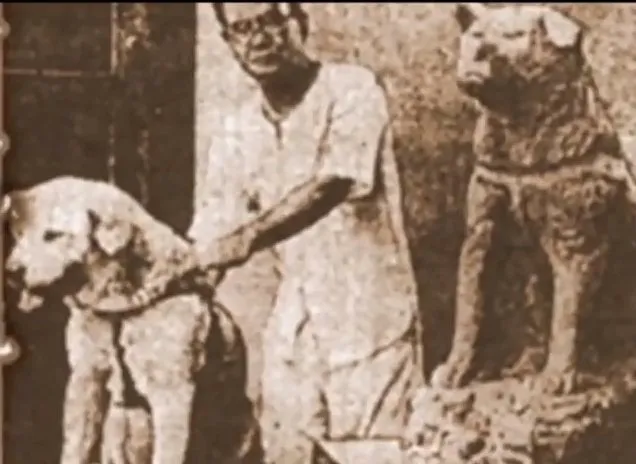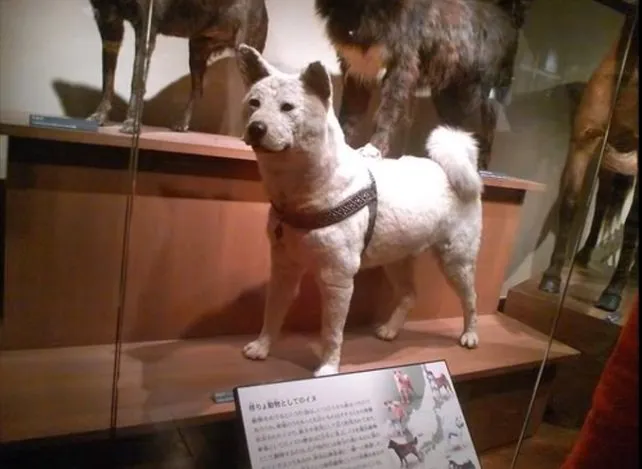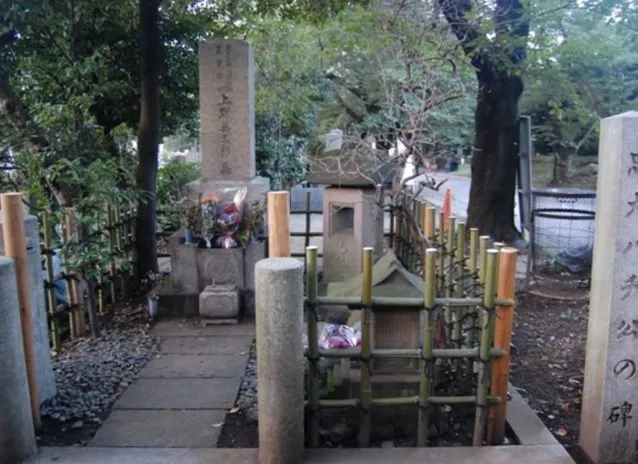Have you ever encountered a story so profoundly moving that it stays with you long after it’s told? For many dog lovers and movie enthusiasts, the tale of Hachiko, the loyal Akita dog, perfectly fits this description. While the legend of Hachiko originated in Japan, its universal themes of love and devotion captivated audiences worldwide, leading to a poignant American film adaptation. “Hachiko: A Dog’s Story,” the Akita Dog Movie With Richard Gere, brought this incredible true story to a global stage, ensuring that Hachiko’s legacy would inspire generations across cultures.
This article delves into the heartwarming and heartbreaking true story of Hachiko, the iconic Akita, and then explores the powerful cinematic interpretation that allowed millions to experience the profound bond between a man and his dog. From the bustling streets of Shibuya to the quiet American suburban train station, we’ll uncover how this faithful canine became a global symbol of unwavering loyalty, and how the film adaptation starring Richard Gere cemented his place in popular culture.
The Legend of Hachiko: A Story of Unwavering Loyalty
The incredible journey of Hachiko began in the serene farmlands of Japan. In 1923, an agricultural science professor from the University of Tokyo, Hidesaburō Ueno, longed for a purebred Japanese Akita. His search concluded when one of his students helped him acquire an Akita puppy from Odate City, in the Akita prefecture.
Born on November 10, 1923, this Akita puppy embarked on a challenging 20-hour train journey to Tokyo. Upon arrival at Professor Ueno’s home on January 15, 1924, the little puppy was in such poor condition that he was initially thought to be dead. However, with the devoted care of Professor Ueno and his girlfriend Yae, the puppy nursed back to health, growing into a strong and vibrant dog over the next six months. The professor named his new companion Hachi, meaning “eight” in Japanese—a number considered lucky in Japanese culture.
Hachi and Professor Ueno quickly formed an unbreakable bond, becoming the best of friends. The professor cherished Hachi like a son, and the two were inseparable. Their daily ritual became a testament to their deep connection: every morning, Hachi would accompany Professor Ueno to the Shibuya Train Station in central Tokyo, and every afternoon, he would return to the station to greet his beloved owner upon his arrival from work. It was a simple, yet profound, display of mutual affection.
 Hachiko with his owner Professor Ueno
Hachiko with his owner Professor Ueno
This cherished routine, however, was tragically cut short. On May 21, 1925, just over a year and four months after Hachi had joined his family, the loyal Akita sat patiently at the Shibuya train station exit, as he did every day, waiting for Professor Ueno. But his owner never appeared. Unbeknownst to Hachi, Professor Ueno had suffered a cerebral hemorrhage while at work and passed away suddenly at the age of 53.
Following Professor Ueno’s death, Hachi went to live with Kozaburo Kobayashi, a former gardener for the Ueno family. Despite his new home, Hachi’s devotion to his first master remained unwavering. For the remainder of his ten-year life, he continued his daily pilgrimage to Shibuya Train Station. Every afternoon, precisely when his friend’s train was due to arrive, Hachi would appear, waiting patiently for hours, his gaze fixed on the stream of passengers, hoping to catch a glimpse of the man who would never return.
 Hachiko waiting patiently at Shibuya Station
Hachiko waiting patiently at Shibuya Station
Initially, Hachi’s persistent presence at the station was met with indifference, and even unkindness, by some pedestrians, staff, and children. However, the tide turned in 1932 when a reporter for a major Japanese newspaper picked up on Hachi’s incredible loyalty and published his story. This article transformed Hachi into a national celebrity, earning him the affectionate title “Chuken-Hachiko,” meaning “Hachiko – the faithful dog.”
People from all corners of Japan, touched by the story of Hachiko the loyal dog, began visiting Shibuya Station to offer Hachiko treats and pay their respects. His unwavering dedication touched the hearts of the Japanese people, solidifying his status as a national hero and a powerful symbol of loyalty, devotion, and love. Hachiko continued his daily vigil for an astonishing nine years, nine months, and 15 days, until his own peaceful passing on March 8, 1935, at the age of 11. His story, often sought after by those looking for a dog movie true story list, remains one of the most compelling narratives of canine fidelity.
“Hachiko: A Dog’s Story” (2009): The Akita Dog Movie with Richard Gere That Touched the World
The profound emotional resonance of Hachiko’s true story naturally lent itself to cinematic adaptations. While a Japanese film, “Hachiko Monogatari,” was released in 1987, it was the 2009 American production, “Hachiko: A Dog’s Story,” starring Richard Gere, that introduced this incredible tale to a vast global audience. This Akita dog movie with Richard Gere expertly translated the cultural nuances of the original story into a universally relatable narrative about a dog’s unwavering loyalty.
Bringing Hachiko’s Story to the West
The decision to create an American adaptation of Hachiko’s story aimed to broaden its appeal, demonstrating that themes of devotion and companionship transcend geographical and cultural boundaries. Director Lasse Hallström took on the challenge of retelling this beloved Japanese legend for a Western audience, carefully balancing respect for the original events with an accessible narrative style. The film, officially titled “Hachiko: A Dog’s Story (2009),” became a powerful vehicle for sharing this unique bond with millions.
Richard Gere as Professor Parker Wilson
Central to the film’s success was the casting of Richard Gere as Professor Parker Wilson, the American equivalent of Professor Hidesaburō Ueno. Gere’s portrayal brought a quiet warmth and intellectual curiosity to the character, perfectly embodying the gentle professor who forms an extraordinary connection with a stray Akita puppy. His performance conveyed the profound love and understanding between man and dog without needing extensive dialogue, allowing the emotional weight of Hachiko’s loyalty to shine through. Gere’s empathetic acting made Professor Wilson’s passing all the more heartbreaking, setting the stage for Hachiko’s enduring vigil.
The Canine Stars: Bringing Hachi to Life
The titular role of Hachi was shared by three magnificent Akita dogs: Layla, Chico, and Forrest. Their trainers meticulously worked to ensure that each dog accurately conveyed the Akita’s dignified demeanor, intelligence, and deep emotional capacity. The selection of the Akita breed for the movie was crucial; their distinctive appearance and known loyalty were integral to the authenticity of the story. The film effectively showcased the Akita’s unique traits, from their stoic expressions to their powerful, quiet devotion, making the canine performances as memorable as the human ones. This choice reinforced why many consider the Akita the perfect breed for such a profound story of faithfulness.
Plot Summary and Emotional Resonance
The film begins with a young boy presenting his class with a report on his hero, Hachi, and the enduring lesson of loyalty. It then flashes back to Professor Parker Wilson discovering an abandoned Akita puppy at his local train station. Against his wife’s initial reluctance, Parker takes the puppy home, naming him Hachi. Their bond deepens, and Hachi soon adopts the ritual of accompanying Parker to the train station each morning and greeting him every afternoon. The movie masterfully builds this everyday routine, making the audience invest deeply in their relationship.
The turning point, mirroring the true story, comes when Professor Wilson tragically dies from a cerebral hemorrhage during a lecture. The film then focuses almost entirely on Hachi’s unwavering wait at the station. Day after day, year after year, Hachi returns to his spot, patiently waiting for a reunion that will never come. The film uses minimal dialogue during these scenes, relying on the dogs’ performances, the subtle changes in the weather, and the reactions of the station master and local vendors to convey the passage of time and Hachi’s relentless devotion. This simple yet powerful narrative arc is what makes the movie with dog named Hachi so emotionally impactful. It’s a testament to the fact that profound love doesn’t require words.
Critical Reception and Box Office
While “Hachiko: A Dog’s Story” had a limited theatrical release in the United States, it garnered significant critical acclaim for its heartfelt portrayal of loyalty and its touching narrative. Many reviewers praised its emotional depth and the powerful performances, particularly by the Akita dogs. The film found its true success and global audience through DVD sales and international distribution, becoming a beloved classic among animal lovers and often cited as one of the most tear-jerking films ever made. Its enduring popularity solidified its place as the Akita dog movie with Richard Gere.
Filming Locations and the Woonsocket, Rhode Island Statue
Although the film is set in the fictional town of Bedridge, its primary filming location was Woonsocket, Rhode Island. The historical Woonsocket Depot Square served as the backdrop for the train station scenes, lending an authentic, classic American small-town feel to the movie.
In a beautiful tribute to the film and the story it represents, a bronze statue of Hachiko was erected at the Woonsocket Depot Square. This statue is a replica of the famous original Hachiko statue in Shibuya, Tokyo, and stands as a permanent reminder of the loyalty depicted in the film. For fans of the Akita dog movie with Richard Gere, this site offers a tangible connection to the beloved story.
Comparing the American and Japanese Adaptations
It’s worth noting that “Hachiko: A Dog’s Story” is not the first cinematic rendition of this legend. Japan produced its own film, “Hachiko Monogatari,” in 1987. While both films tell the true story of a loyal dog, they differ in tone and cultural context. The Japanese version often carries a more traditional, understated emotional depth, deeply rooted in Japanese values. The American film, on the other hand, while equally emotional, offers a more universal approach, adapting the setting and character names to resonate with a Western audience. Both, however, serve as powerful tributes to Hachiko’s enduring spirit.
The Akita Dog: Loyalty Embodied
The choice of an Akita dog for Hachiko’s story is not accidental. The Akita Inu, an ancient and noble Japanese breed, is renowned for its profound loyalty, intelligence, and dignified demeanor. These dogs are known to form incredibly strong bonds with their owners, often displaying a fierce protective instinct and an unwavering devotion that can be breathtaking.
Akitas are powerful, large dogs with a striking appearance, characterized by their curled tails and thick double coats. While they are often described as independent and reserved, particularly with strangers, their affection for their family is deep and abiding. They require consistent training and socialization from a young age due to their strong will and protective nature. For prospective owners, understanding the Akita’s unique temperament is key to a harmonious relationship. Their loyalty, as perfectly exemplified by Hachiko, is not given lightly but, once earned, is absolute.
Hachiko’s Enduring Legacy: Statues, Museums, and Memorials
Hachiko’s story extends far beyond the silver screen and into the very fabric of Japanese culture and beyond. His legacy is immortalized in various forms, serving as constant reminders of his unparalleled devotion.
1. The Famous Hachiko Statue at Shibuya Station
The most iconic and frequently visited monument is the bronze statue located directly in front of Shibuya Station in Tokyo. Erected in 1934 by Japanese artist Teru Andō, this statue was unveiled in a grand ceremony where Hachiko himself was the guest of honor. Today, it stands as one of Tokyo’s most popular tourist attractions and a beloved meeting point, especially among the youth. The entrance where visitors exit Shibuya Station to find the statue is even named “Hachikō-guchi,” meaning “The Hachikō Entrance/Exit.”
This statue, however, is not the original. The first was melted down for metal during World War II. The current statue, a testament to Hachiko’s enduring importance, was created in 1948 by Takeshi Ando, the son of the original artist.
 Hachiko statue at Shibuya Crossing
Hachiko statue at Shibuya Crossing
Hachiko Annual Memorial Ceremony – March 8
Every year, on March 8th, the anniversary of Hachiko’s passing, a heartfelt memorial ceremony is held at Shibuya Station. This event honors Hachi and celebrates the universal values of love and loyalty that he embodies. The 2023 ceremony was particularly significant, marking what would have been Hachiko’s 100th birthday, drawing a large crowd of admirers.
2. Hachiko Mosaic at Shibuya Station
On a wall within Shibuya Station, a magnificent mosaic artwork titled “Hachiko Family” can be found. Created by Japanese artist Ryutaro Kitahara and completed in 1990, this vibrant mural depicts Hachiko playing joyfully with his parents and siblings, offering a heartwarming glimpse into his imagined past.
3. Stuffed Hachiko at the National Museum of Nature and Science, Tokyo
When Hachiko passed away peacefully on March 8, 1935, near Shibuya Station, his significance as a national symbol of loyalty led to his preservation. Today, visitors can see the stuffed and preserved remains of Hachiko at the National Museum of Nature and Science in Ueno, Tokyo, allowing for a tangible connection to the legendary dog.
 Stuffed Hachiko at the National Museum of Nature and Science
Stuffed Hachiko at the National Museum of Nature and Science
4. Hachiko & Professor Ueno Statue at the University of Tokyo
Perhaps one of the most emotionally resonant monuments is the bronze statue at the University of Tokyo, depicting a joyous reunion between Hachiko and his best friend, Professor Hidesaburō Ueno. Erected on March 9, 2015, on the 80th anniversary of Hachiko’s death, this statue, created by Tsutomu Ueda, captures Hachiko leaping with excitement to greet his returning master. It’s a powerful visual representation of the bond that defines their story. Next to the statue, a small museum displays articles, photos, and even Hachiko’s autopsy report, detailing his passing from terminal cancer and a filaria infection.
5. Hachiko Monument at Professor Ueno’s Grave
While Hachiko’s fur was preserved for the museum, his remains were cremated. His ashes were fittingly interred beside his beloved owner, Professor Ueno, in Aoyama Cemetery in Minato, Tokyo. A monument of Hachiko stands beside his owner’s tomb, ensuring their eternal companionship.
 Hachiko monument next to Professor Ueno's tomb
Hachiko monument next to Professor Ueno's tomb
Akita Hachiko Dog Museum – Odate City
For those deeply interested in the Akita breed and Hachiko’s origins, the Akita Dog Museum in Odate City, Akita prefecture, is a must-visit. This museum offers comprehensive insights into the Akita dog and, of course, Hachiko. On weekdays, visitors can even interact with resident Akita dogs, a truly delightful experience for animal lovers. Odate City itself is the “capital city” of the Akita breed, adorned with statues and symbols of the loyal canine, including a Hachiko statue at Odate Station and Hachiko-themed manhole covers.
Beyond the Silver Screen: Other Ways to Connect with Hachiko’s Story
The enduring appeal of Hachiko’s story isn’t limited to the screen. For those who wish to delve deeper into the narrative of the Akita dog movie with Richard Gere and its true origins, numerous resources are available:
Books About Hachiko
Several excellent books chronicle Hachiko’s life and the profound impact of his story. These literary works offer different perspectives and details, enriching the understanding of his incredible loyalty. They serve as wonderful companions to the film, providing deeper context and historical insights.
Visiting Tokyo and Exploring Hachiko’s World
For the ultimate Hachiko experience, a visit to Tokyo is essential. Fans can walk the streets where Hachiko once waited, visit his famous statue at Shibuya Station, pay respects at the monument beside Professor Ueno’s tomb in Aoyama Cemetery, and see Hachiko himself at the National Museum of Nature and Science in Ueno. Each location offers a unique perspective on the legend and its cultural significance.
Conclusion
The story of Hachiko, the loyal Akita, stands as one of the most powerful testaments to the extraordinary bond between humans and dogs. From his humble beginnings in Odate City to his daily vigil at Shibuya Station, Hachiko’s unwavering devotion transcended time and place, capturing the hearts of a nation.
The Akita dog movie with Richard Gere, “Hachiko: A Dog’s Story,” beautifully brought this timeless tale to the international stage. Through its heartwarming narrative and poignant performances, the film allowed millions to feel the depth of Hachiko’s love and loyalty, reminding us all of the profound emotional connections we share with our canine companions. Hachiko’s legacy, preserved in statues, museums, and countless stories, continues to inspire, teaching us about faithfulness, patience, and the boundless capacity for love that truly makes dogs man’s best friend. Whether you encounter his story through film, literature, or a visit to his memorials in Japan, Hachiko’s spirit will undoubtedly leave an indelible mark on your heart.
References
- Itoh, Mayumi. Hachiko: The True Story of the Royal Dog of Japan. New York: Atria Books, 2013.
- “Hachiko: A Dog’s Story.” IMDb. https://www.imdb.com/title/tt1028402/
- Akita Dog Museum Official Website. http://www.akitainu-hozonkai.com/?lang=en
- National Museum of Nature and Science Official Website. https://www.kahaku.go.jp/english/
